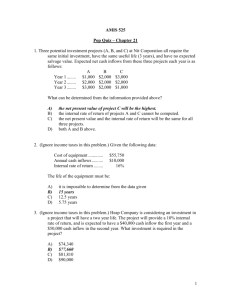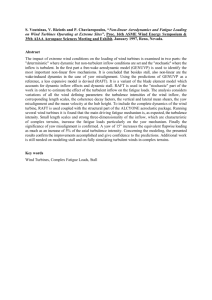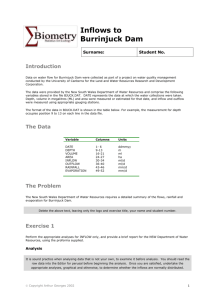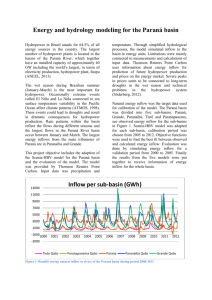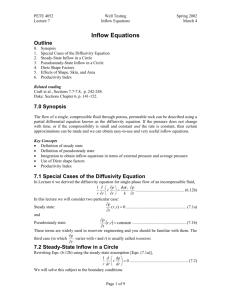ppt
advertisement
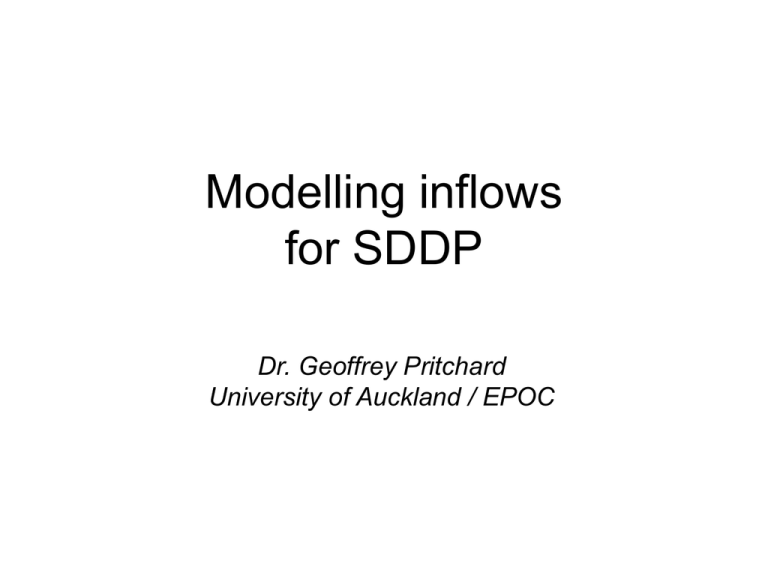
Modelling inflows for SDDP Dr. Geoffrey Pritchard University of Auckland / EPOC Inflows – where it all starts CATCHMENTS thermal generation reservoirs hydro generation transmission consumption In hydro-dominated power systems, all modelling and evaluation depends ultimately on stochastic models of natural inflow. Why models? • Raw historical inflow sequences get us only so far. - they can’t deal with situations that have never happened before. • Autumn 2014 : - Mar ~ 1620 MW - Apr ~ 2280 MW - May ~ 4010 MW Past years (if any) with this exact sequence are not a reliable forecast for June 2014. What does a model need? 1. Seasonal dependence. - Everything depends what time of year it is. Waitaki catchment (above Benmore dam) 1948-2010 What does a model need? 2. Serial dependence. - Weather patterns persist, increasing probability of shortage/spill. - Typical correlation length ~ several weeks (but varying seasonally). Iterated function systems Let xt NorthIsland inflow in week t yt South Island inflow Make this a Markov process by applying randomly-chosen linear transformations, as in: 0.2 0.4 xt 0.5 , 50% chance xt 1 0.7 0.6 yt 0.6 yt 1 0.8 0.5 xt 0.4 0.1 0.9 y 0.7 , 50% chance t (numerical values are only to illustrate the form of the model). IFS inflow models Differences from IFS applications in computer graphics: • Seasonal dependence - the “image” varies periodically, a repeating loop. • Serial dependence - the order in which points are generated matters. Single-catchment version Model for inflow Xt in week t : X t Rt St X t 1 - where (Rt, St) is chosen at random from a small collection of (seasonally-varying) scenarios. The possible (Rt, St) pairs can be devised by quantile regression: - each scenario corresponds to a different inflow quantile. Scenario functions for the Waitaki High-flow scenarios differ in intercept (current rainfall). Low-flow scenarios differ mainly in slope. Extreme scenarios have their own dependence structure. Exact mean model inflows • We can specify the exact mean of the IFS inflow model. Inflow Xt in week t : X t Rt St X t 1 Take averages to obtain mean inflow mt in week t : mt rt st mt 1 where (rt, st) are the averages of (Rt, St) across scenarios. • Usually we know what we want mt (and mt-1) to be; the resulting constraint on (rt, st) can be incorporated into the model fitting process, guaranteeing an unbiased model. • Similarly variances. • Control variates in simulation. Inflow distribution over 4-month timescale. (Model simulated for 100 x 62 years, dependent weekly inflows, general linear form.) Hydro-thermal scheduling by SDDP • The problem: Operate a combination of hydro and thermal power stations - meeting demand, etc. - at least cost (fuel, shortage). • Assume a mechanism (wholesale market, or single system operator) capable of solving this problem. • What does the answer look like? Structure of SDDP Week 6 Week 7 Week 8 Structure of SDDP Week 6 Week 7 min (present cost) + E[ future cost ] s.t. (satisfy demand, etc.) Week 8 Structure of SDDP Week 6 S ps Week 7 Week 8 min (present cost) + E[ future cost ] s.t. (satisfy demand, etc.) s - Stage subproblem is (essentially) a linear program with discrete scenarios. Why IFS for SDDP inflows? • The SDDP stage subproblem is (essentially) a linear program with discrete scenarios. • Most stochastic inflow models must be modified/approximated to make them fit this form, but ... • … the IFS inflow model already has the final form required to be usable in SDDP.
